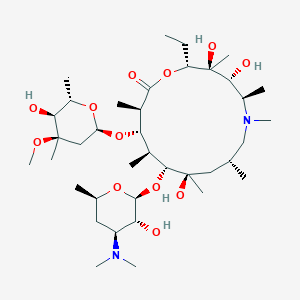Community-acquired pneumonia
Adult: 500 mg as a single daily dose for at least 2 days, given at a rate of 1 mg/mL over 3 hours or 2 mg/mL over 1 hour, followed by oral dose of 500 mg daily to complete 7-10 days.
Intravenous
Pelvic inflammatory disease
Adult: 500 mg daily as a single dose for 1 or 2 days, given at a rate of 1 mg/mL over 3 hours or 2 mg/mL over 1 hour, followed by oral dose of 250 mg daily to complete 7 days.
Ophthalmic
Bacterial conjunctivitis
Adult: As 1% solution: Instill 1 drop into affected eye(s) bid (8-12 hours apart) for 2 days then 1 drop once daily for the next 5 days. As 1.5% (as dihydrate) solution: Instill 1 drop into the conjunctival fornix bid (morning and evening) for 3 days.
Child: As 1% solution: ≥1 year Same as adult dose. As 1.5% solution: Same as adult dose.
Child: As 1% solution: ≥1 year Same as adult dose. As 1.5% solution: Same as adult dose.
Oral
Chancroid, Uncomplicated genital infections due to Chlamydia trachomatis
Adult: 1 g as a single dose.
Oral
Prophylaxis of disseminated Mycobacterium avium complex (MAC) infections
Adult: 1.2 g once weekly.
Oral
Acute otitis media
Child: ≥6 months As immediate release suspension: 30 mg/kg as a single dose or 10 mg/kg once daily for 3 days or 10 mg/kg as a single dose in day 1, followed by 5 mg/kg/day on days 2-5.
Oral
Acute bacterial sinusitis
Adult: As tab, cap or immediate release suspension: 500 mg once daily for 3 days. As extended release suspension: 2 g as a single dose.
Child: As immediate release suspension: 10 mg/kg once daily for 3 days.
Child: As immediate release suspension: 10 mg/kg once daily for 3 days.
Oral
Respiratory tract infections, Skin and soft tissue infections
Adult: As tab, cap, or immediate release suspension: 500 mg daily for 3 days. Alternatively, 500 mg as single dose on day 1 followed by 250 mg daily on days 2-5.
Child: ≥6 months As immediate release suspension: 10 mg/kg daily for 3 days or 10 mg/kg on day 1, followed by 5 mg/kg/day on days 2-5. >45 kg: Same as adult dose.
Child: ≥6 months As immediate release suspension: 10 mg/kg daily for 3 days or 10 mg/kg on day 1, followed by 5 mg/kg/day on days 2-5. >45 kg: Same as adult dose.
Oral
Uncomplicated gonorrhoea
Adult: 1 g or 2 g as a single dose, in combination with ceftriaxone.
Oral
Pharyngitis, Tonsillitis
Child: >2 years As immediate release preparation: 12 mg/kg/day for 5 days.
Oral
Community-acquired pneumonia
Adult: As tab, cap, or immediate release suspension: 500 mg on day 1, followed by 250 mg once daily on days 2-5. As extended release suspension: 2 g as a single dose.
Child: ≥6 months As immediate release suspension: 10 mg/kg as single dose on day 1 followed by 5 mg/kg/day on days 2-5. As extended release suspension: 60 mg/kg as a single dose. Max: 2 g.
Child: ≥6 months As immediate release suspension: 10 mg/kg as single dose on day 1 followed by 5 mg/kg/day on days 2-5. As extended release suspension: 60 mg/kg as a single dose. Max: 2 g.




 Sign Out
Sign Out




